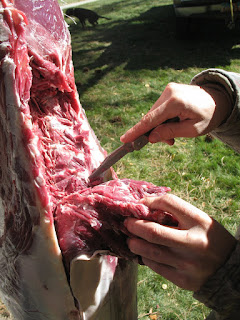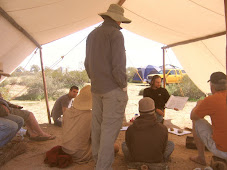 Yup, that's it. A few sticks and some cordage with a "toggle" piece attached. The sticks, made from pine, can be fashioned out of any sturdy type of wood. The uppermost stick in the photo -- the top-piece -- has cordage tied on and a notch carved into it for reasons you'll understand in a little bit. The other stick -- the foundation piece -- is carved to a flat point to fit nicely into the top-piece's notch; it's two stubby "legs" give it more stability when setting the trap. The cordage is made from artificial sinew, but any strong natural fibers will do. When I lived in the Sonoran desert, I was a big fan of yucca and agave fibers. I'll leave natural cordage-making skills for another time, though.
Yup, that's it. A few sticks and some cordage with a "toggle" piece attached. The sticks, made from pine, can be fashioned out of any sturdy type of wood. The uppermost stick in the photo -- the top-piece -- has cordage tied on and a notch carved into it for reasons you'll understand in a little bit. The other stick -- the foundation piece -- is carved to a flat point to fit nicely into the top-piece's notch; it's two stubby "legs" give it more stability when setting the trap. The cordage is made from artificial sinew, but any strong natural fibers will do. When I lived in the Sonoran desert, I was a big fan of yucca and agave fibers. I'll leave natural cordage-making skills for another time, though.The dimensions pictured are by no means the only way to go about making this trap, but they seem to work well for me. All of the fancy carvings on the sticks aren't really neccesary, but I find them helpful in allowing me to adjust the length of cord on-the-fly by wrapping it around the top-piece, as well as securing the cord better on the bottom foundation piece. Below is what the trap looks like once it's set (here, you can see more clearly how I used the carvings):

 You'll notice that, to complete the trap, I had to (1) find a rock with a nice flat bottom and wide base and (2) attain a long, thin bait stick to thread underneath the rock. Obviously, if I was actually setting this trap to procure an animal, I'd have speared some bait onto the bait stick before setting, such as local wild plants that a small animal might like -- maybe pinyon pine nuts, seed heads of various grasses -- or food I might have with me as trail snacks, such as raisins or peanut butter. Mice seem to really love raisins. Although no rodents came along after I set it, to my good fortune (and perhaps to the benefit of the more squeamish readers of this blog), this particular trap attracted a wild desert tangerine!
You'll notice that, to complete the trap, I had to (1) find a rock with a nice flat bottom and wide base and (2) attain a long, thin bait stick to thread underneath the rock. Obviously, if I was actually setting this trap to procure an animal, I'd have speared some bait onto the bait stick before setting, such as local wild plants that a small animal might like -- maybe pinyon pine nuts, seed heads of various grasses -- or food I might have with me as trail snacks, such as raisins or peanut butter. Mice seem to really love raisins. Although no rodents came along after I set it, to my good fortune (and perhaps to the benefit of the more squeamish readers of this blog), this particular trap attracted a wild desert tangerine! Notice the rocks I stacked on top of the main rock after setting the trap. This increases the weight and, thus, crushing force and speed of the deadfall. It also allows me to evaluate the stability of the trap. Now let's trigger the trap, lift the rock, and see what happens to the unsuspecting tangerine:
Notice the rocks I stacked on top of the main rock after setting the trap. This increases the weight and, thus, crushing force and speed of the deadfall. It also allows me to evaluate the stability of the trap. Now let's trigger the trap, lift the rock, and see what happens to the unsuspecting tangerine: Ouch! As you can see, when the bait stick is tugged at or nudged in any way, the trap is triggered and the rock falls abrubtly, leaving very little time for the animal (or, in this case, fruit) to escape. The main components of the Paiute deadfall spring neatly into the air and out of the way of the rock, allowing the rock to lay perfectly flesh with the ground (or, ideally, a hard, flat rock underneath) -- only the thin bait stick, along with the bait, actually receives the impact. The unlucky creature who happened to trigger the trap is instantly crushed to death. Squish! Mouse pancakes!
Ouch! As you can see, when the bait stick is tugged at or nudged in any way, the trap is triggered and the rock falls abrubtly, leaving very little time for the animal (or, in this case, fruit) to escape. The main components of the Paiute deadfall spring neatly into the air and out of the way of the rock, allowing the rock to lay perfectly flesh with the ground (or, ideally, a hard, flat rock underneath) -- only the thin bait stick, along with the bait, actually receives the impact. The unlucky creature who happened to trigger the trap is instantly crushed to death. Squish! Mouse pancakes!For brevity's sake, I'm going to leave a more detailed discussion of this trap to Jim Riggs, one of the great influences of the primitive skills movement and a man with a lot of "dirt time." His article "Rocking On with the Paiute Deadfall" is by far the most thorough and well-written piece I have seen on this subject. Those of you out there in cyberland who want to experiment with a Paiute deadfall will benefit greatly from Mr. Riggs' description of the trap.
Also, a very good explanation of the Paiute deadfall is given in this video. I've never met the man who made this tutorial (Mark Lummio of Bushcraft Northwest), but he seems to really know what he's talking about. Absolutely fantastic video.
In the next post, I'll get into the nutritional and caloric details of small game animals that a person might find underneath his or her deadfall rocks day to day; and I'll evaluate the realities inherent in living off of such fare as Matt Graham did: processing, cooking, and eating trapped animals to thrive -- not just survive -- in the wilderness primitively.
Thanks to my good pal, Jeff Macdonald, for helping with the pictures.


 Roadkill Mule Deer: $417. A true country delicacy.
Roadkill Mule Deer: $417. A true country delicacy.










 Over the course of the 19th century, as heart disease has increased and cancer has become a common cause of death in the United States, saturated fat consumption has remained quite stable. Monounsaturated fat consumption has increased substantially. Yet this change pales in comparison to the growing popularity of polyunsaturated fat in the American diet. In the 1950s, with polyunsaturated vegetable oils gaining favor by the edible oil industries (whose primary motivation was to make a profit), Americans began eating more and more of these unnatural, man-made fats -- fats which were traditionally only consumed as whole foods, such as grains, vegetables, seeds, and nuts.
Over the course of the 19th century, as heart disease has increased and cancer has become a common cause of death in the United States, saturated fat consumption has remained quite stable. Monounsaturated fat consumption has increased substantially. Yet this change pales in comparison to the growing popularity of polyunsaturated fat in the American diet. In the 1950s, with polyunsaturated vegetable oils gaining favor by the edible oil industries (whose primary motivation was to make a profit), Americans began eating more and more of these unnatural, man-made fats -- fats which were traditionally only consumed as whole foods, such as grains, vegetables, seeds, and nuts. In the above figure, we see that infant mortality rates in 1900 are quite high at 14 %. Correspondingly, average life expectancy of newborns in 1900 is very low at 47.6 years. In 1992, with infant deaths (along with infectious disease, undernourishment, and death from injury) being largely controlled by medical technological advancements, the infant mortality rate drops drastically to less than 1%. For that year, we find that life expectancy has risen by nearly 30 years compared to data from the year 1900.
In the above figure, we see that infant mortality rates in 1900 are quite high at 14 %. Correspondingly, average life expectancy of newborns in 1900 is very low at 47.6 years. In 1992, with infant deaths (along with infectious disease, undernourishment, and death from injury) being largely controlled by medical technological advancements, the infant mortality rate drops drastically to less than 1%. For that year, we find that life expectancy has risen by nearly 30 years compared to data from the year 1900..jpg) Here we see that if a white American in 1900 reaches age 40, he/she can expect to live 28 years longer (age 68). A white American in 1992 is expected to live 39 years longer (age 79). This is a difference of 11 years. Furthermore, if the 1900 person should live to age 80, he/she is expected to reach age 85. If the 1992 man lives to 80 years, he can expect to see age 87. This is a difference of 2 years. Thus, it can be seen in the above figure that as the age of the individual increases, the gap between the life expectancy data of 1900 and 1992 diminishes. Returning to the first figure, which is based on newborn (age 0) life expectancies, we find a much larger gap in the data -- a difference of nearly 30 years.
Here we see that if a white American in 1900 reaches age 40, he/she can expect to live 28 years longer (age 68). A white American in 1992 is expected to live 39 years longer (age 79). This is a difference of 11 years. Furthermore, if the 1900 person should live to age 80, he/she is expected to reach age 85. If the 1992 man lives to 80 years, he can expect to see age 87. This is a difference of 2 years. Thus, it can be seen in the above figure that as the age of the individual increases, the gap between the life expectancy data of 1900 and 1992 diminishes. Returning to the first figure, which is based on newborn (age 0) life expectancies, we find a much larger gap in the data -- a difference of nearly 30 years.


